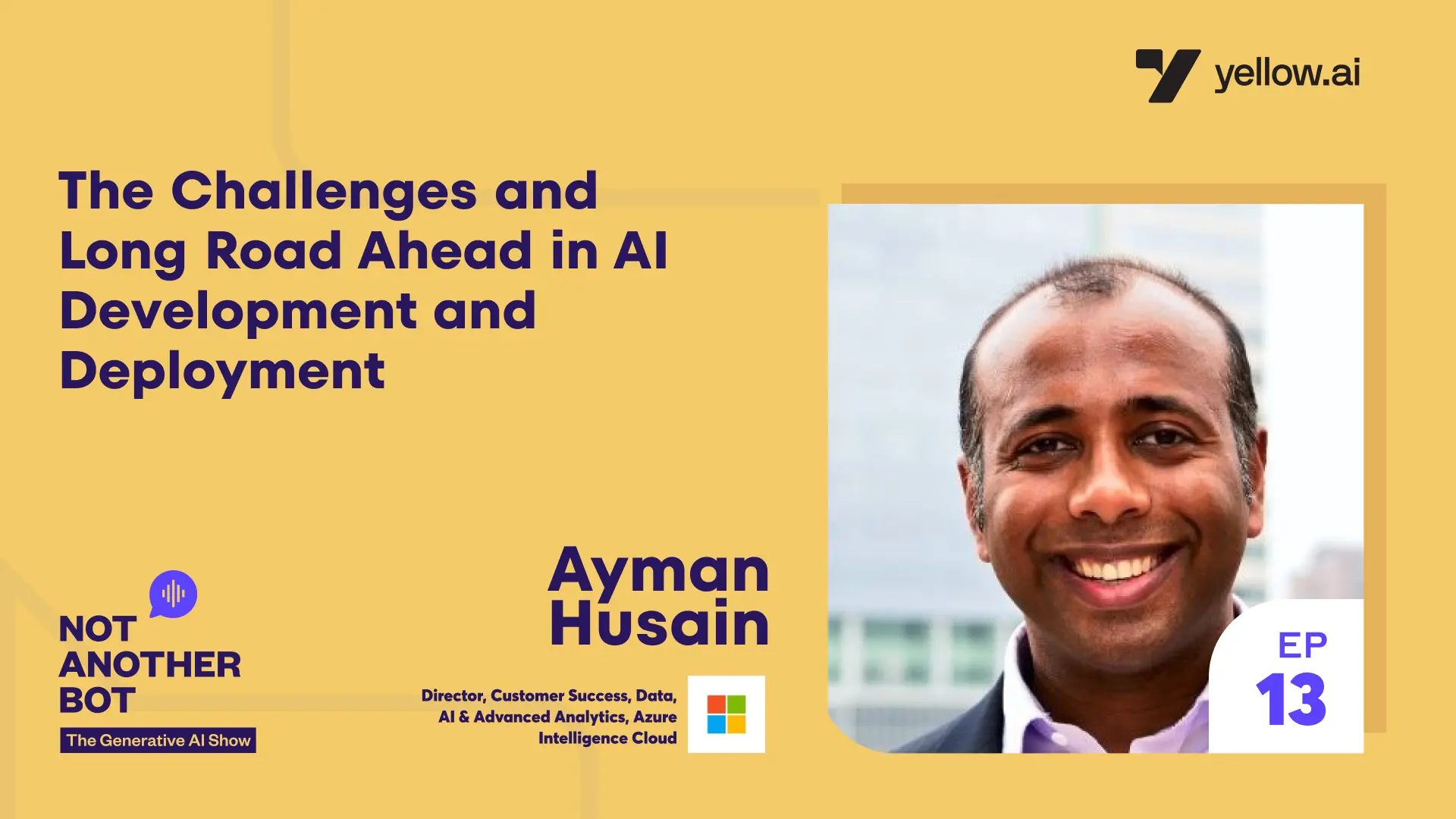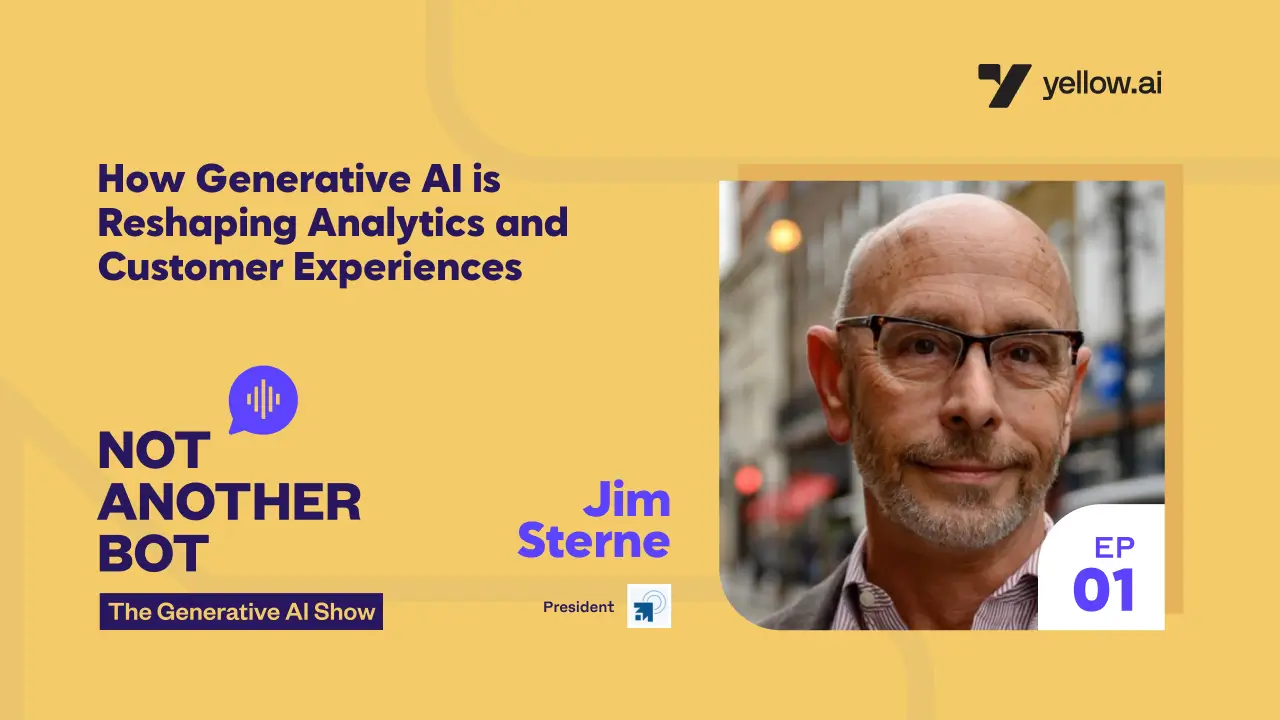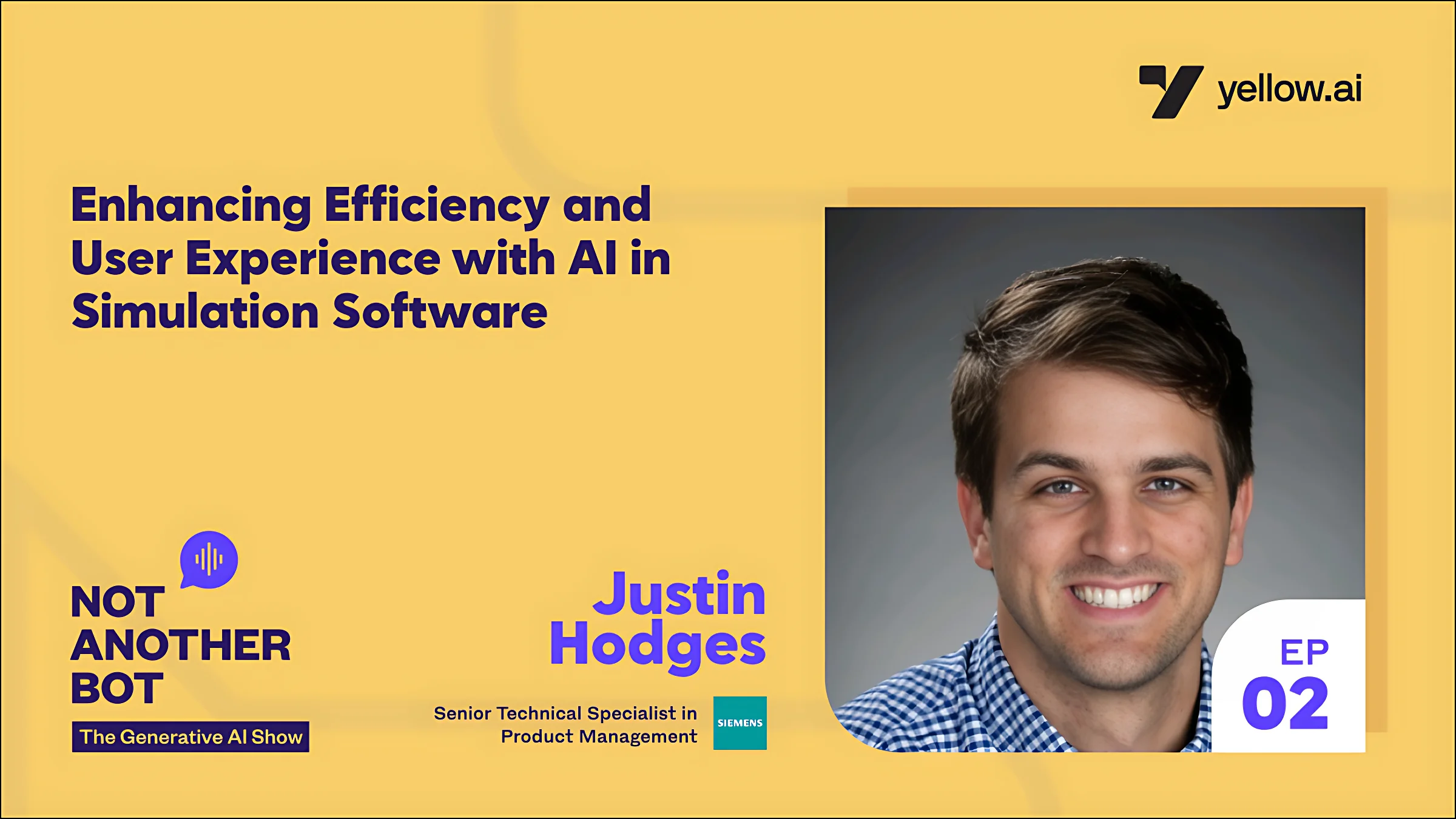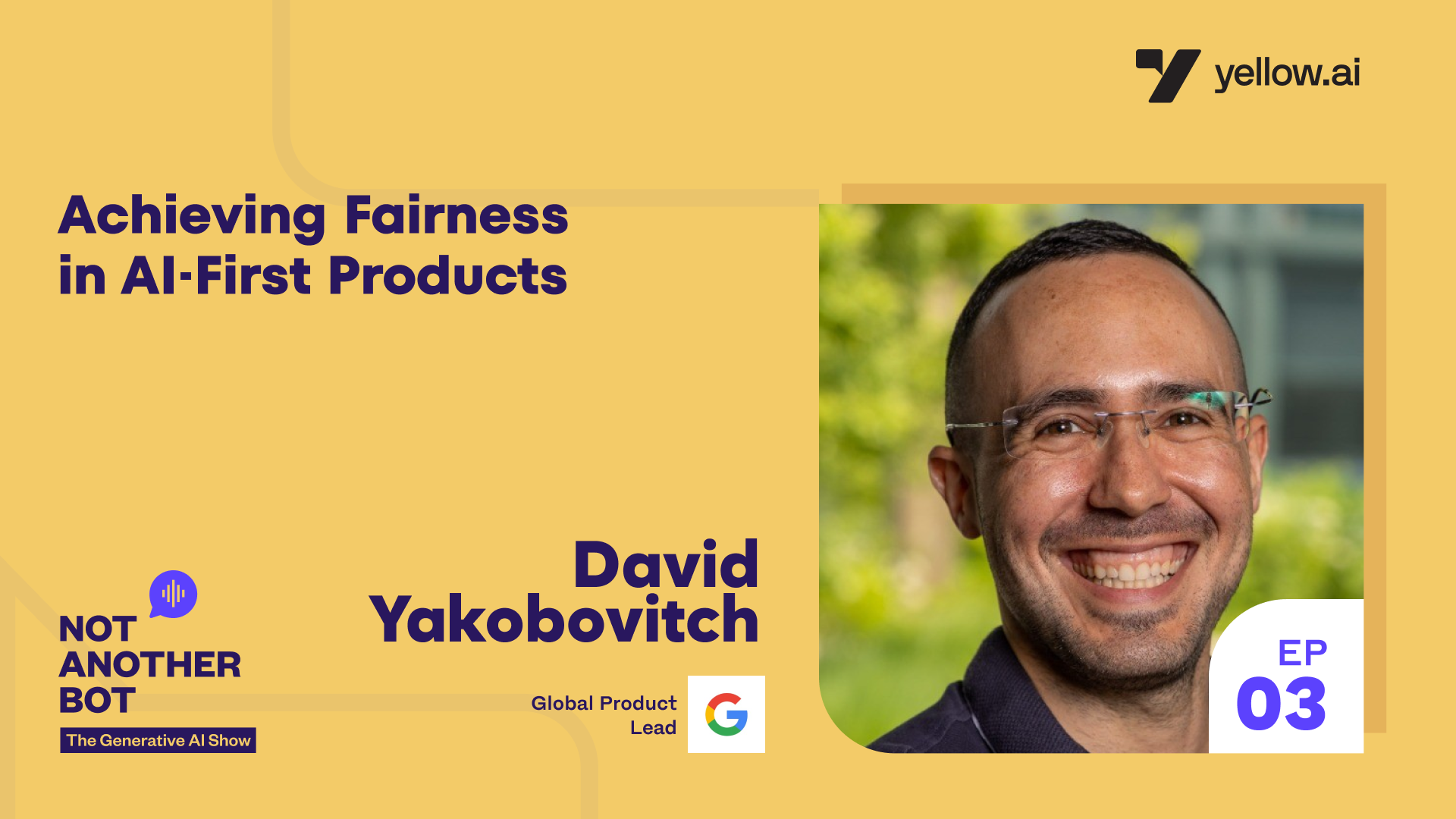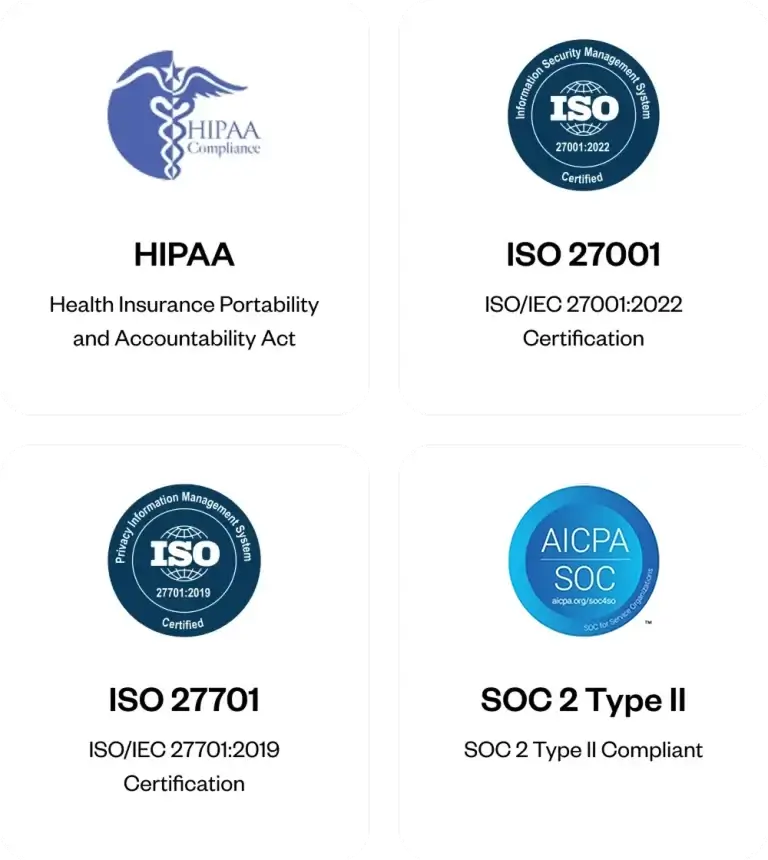Transcript
Intro – 00:00:03: Generative AI takes the center stage. But is your enterprise still watching from the sidelines? Come on in. Let’s fix that. Not Another Bot: The Generative AI Show, where we unpack and help you understand the rapidly evolving space of conversational experiences and the technology behind it all. Here is your host, TJ.
TJ – 00:00:26: Hello, and welcome to Not Another Bot: The Generative AI Show. I’m your host, TJ. Joining us today is Ayman Husain , the Director of Customer Success, Data AI, and Advanced Analytics at Microsoft’s Azure Intelligent Cloud. With a background that spans technology, consulting, and cloud architecture, Ayman has become an influential figure in guiding organizations through their digital transformation journeys. His expertise in artificial intelligence, big data, and cloud-native application design has made him a go-to leader for business aiming to innovate and succeed in today’s fast-paced technology landscape. Welcome, Ayman.
Ayman Husain – 00:01:02: It’s great to be here, TJ. Thank you for having me.
TJ – 00:01:04: Brilliant. Ayman, you have been a leader at Microsoft focusing on customer success. Well, one thing that certainly intrigues me a lot is if you could share some of the anecdotal or aha moments that made you truly appreciate the power of generative AI as a tool for augmenting human capabilities, would be awesome to hear.
Ayman Husain – 00:01:23: Absolutely. So one of the things, especially in the role of customer success at Microsoft or any other organization, is being able to respond to the customer outcomes in a timely fashion. And one of the things is we are all humans and we have a particular way we interact with each other. There are some process, there are some pillars, there are some disciplines. But ultimately, it is task-oriented, it is oriented around the person and the people based on data they provide or the data you have. What generative AI is doing for us in customer success or in the context of how we connect with our customers is making sure that we have those touch points and a frequency that brings us closer, helps us build that customer relationship even more powerfully. And those tools and processes are doing things that are human-oriented in the way of repeatability. Like I may forget to send you an email, TJ, because I needed to check on something and, I may forget because of my schedule. But with generative AI and the skills. And, the ability to do recaps and whatnot, you are able to automate these tasks, which it makes you augment yourself to do more with less. And that is what generative AI is doing. Not only at Microsoft, but also around the industries and in very different communities, either in customer success or software development or otherwise.

“Generative AI has helped us automate tasks and improve customer relationships. It allows us to have touchpoints with customers more frequently and build stronger relationships by automating repetitive tasks and ensuring nothing falls through the cracks. It enables us to do more with less and ultimately be more efficient and effective in our roles.”


Ayman Husain
Director of Customer Success, Data, AI and Advanced Analytics, and Azure Intelligent Cloud at Microsoft.

TJ – 00:02:36: Brilliant. I know that while reading through your journey and the things you have said and the way you have made an impact, there’s one thing that definitely resonated with us is technology should make your jobs faster and quicker. I mean, literally, right? And that the focus should be on customer outcomes. How does generative AI embody these principles for you?
Ayman Husain – 00:02:59: One of the things generative AI does, like the hype cycle, if you remove it, it is essentially a collection of many data sources that you’re using, and language model of some sort or some kind of AI model to infer what it is in that space, right? So when you think of how my job is going to get better or quicker or faster is I already have an amazing amount of data. I just don’t have time to look through it or it’s too complex for me to make sense of it. So a generative AI or AI in general. It’s helping us do more of it’s getting those insights and those insights will tell us what those outcomes the customers want or what outcomes the customers did not want or what outcomes failed miserably. So we shouldn’t try again. And that is what’s helping us be better at it. We’re not going to the customers with outcomes. I know they won’t have. So the way I’m going to harvest that data, maybe if I’m in the commercial sales role, I will actually use their publicly available 10-K reports or sales revenue reports or industry analysis of them. And then I’m going to run it through a generative AI model of some sort and get those highlights. What are stop of mind for their board? What is top of mind for their CEO? And that gives me the ability to have a targeted conversation. Now, I could do old school research. And if you look at the research industry, there was business analysts, there were research analysts that sat there and looked through papers and mounds of data just to give those decision makers the right amount of information. Now you can use generative AI to do it yourself. So you’re doing more with less. I don’t have to sit there and read a Gartner report. I can get all the data right away. And then go target those customers outcomes and get them what they need satisfactorily.
TJ – 00:04:34: Interesting. Now, keeping that dialogue in mind, many organizations are integrating AI, generative AI. Like I can say from our experiences, a lot of our customers are loving our offering of VLOG, which is our own in-house large language model, into their application stack and operations. And they’re seeing tremendous value, especially the human-like interactions. But, certainly sometimes we see or hear the why is sometimes overlooked when especially defining with, you know, we have to explain a lot about the use case definition. But sometimes the why is overlooked in terms of integrating AI or generative AI into their overall ecosystem. Why should companies consider integrating generative AI into their systems today beyond just the allure of cutting-edge technology? Well, some of the customers understand, but then I think broadly, enterprises would really need to understand the maximum benefit of it. How would you explain or kind of talk about it so that enterprises can get the maximum value of it?
Ayman Husain – 00:05:33: So I’m going to use a little bit of a parallel example from a few years ago, almost decades ago. So think of the time when mobile phones did not have the smartphone capability around it. And they still had some kind of data plan. You could do some low-level data exchange, 2G networks in those days, right? Then it became 3G and 4G. And what that did is proliferated this need to have apps on your smartphones that responded in real time very fast and very quick and looked like your desktop apps. So, if you were a developer of mobile phone applications and did not take into consideration what a 3G network looks like, what a 4G network looks like, what Wi-Fi looks like, how to process data at the edge, which would be the smartphone, or at the back end in the technology telecom area, you are going to have a bad user experience. So what I recommend in today’s version of new technology is GenAI. You don’t need to have GenAI in everything you do. Because the world is moving towards that direction. Think of the fact that before iPhone came up with the smartphone that did not have any keyboards, we were used to the BlackBerry type keyboards. We were using actual tactile keys. Then we moved into this non-tactile format. And now we have swipe keyboards where you can just move your fingers around it, right? If you were an app developer and you did not plan for that, you would have bad user interface. So if you think under that forward momentum, we’re getting to the point where using a language, I will speak to my phone and it’ll go do some actions like finding directions or finding recipes or whatever it is. So if you’re an app developer and you’re not incorporating voice recognition and the ability to have user success for it, you are going to miss out. So in the same way, GenAI is very important to almost every facet of life as it’s going to be. We are going to grow up in an ecosystem where GenAI is going to be implicitly. It may not be necessary, but it’ll be implicitly expected. I remember when my youngest was young and we were watching TV, he had this habit of going to the TV and swiping across it because he was used to an iPad. And in an iPad, he could swipe and pictures would change. And he thought the TV would be the same way. So your brain is programmed in that fashion early on. So with GenAI right now, if you’re not putting it in your applications or your workplace or your method of doing business, the next generation of people that will show up will implicitly implicitly expect it. And when they can’t have it, they’ll be like, well, this is kind of retro or not up to date. So everybody should have a context of it. Now, why would you have it is really about the ROI for your business. Unless you’re a nonprofit and doing it for purpose of research, you have an outcome you want. You want to save money. You want to be better at supply chain logistics. You want to service your customers better. If you’re in medical healthcare, you want to make sure people don’t die. Whatever it is, you are in this place of an outcome. You have to dot line that outcome to Generative AI place so that you can create a structure of solutions that uses GenAI to help you better at your job. So let’s say medical professions. If you’re a physician, if you ever go to a dentist or you go to a medical practitioner to just get checked up, you’ll notice they have this system that’s taking notes as a doctor speaking. The doctors got their hands full or they just don’t have enough time for transcribing. Think of that person. Imagine if a doctor could speak right there and then of what they’re doing and GenAI speaking it up, transcribing it, finding diagnosis, finding medicines that they need or having it read back to them. You are now a better caregiver. You’re better at your job. But you don’t need to do it unless you have a metric that requires that. Maybe you want to see more patients faster, quicker, better, or you have a quality issue that you want to get better at. And these are the things that GenAI will help. And so you always want to put GenAI in focus as it is today. You don’t need to have it in everything, but you definitely want to do it. And what that means is you have to skill up people to do a lot of training, learning, development. You have to learn how to do that. You have to have some kind of analysis of your strategy as a company or a firm. Where do you want to do with this? Where are you going to go? Is this a focus for us? If you’re an iron worker making iron rods, maybe GenAI is not necessary at the field level, but maybe it’s necessary at the procurement level where they’re trying to get raw materials, whatnot. So you have to understand where it fits.
TJ – 00:09:46: Totally. And I think that’s one thing which is pretty prominent based on the discussions we are having. It’s not like a spray and pray sort of thing. Like, hey, just put it all in my system, and we will use it for every use case definition, understanding of the model and what it’s going to do for you. And especially for different scenarios, like especially you may have a summarization need, you may have more of a document cognition need. They’re very different use cases from each other. So thank you so much for the very good example to explain this. Now, one thing that certainly to your point, how we, took that example of the healthcare thing, right? So I think one of the key things that we consistently are hearing, and certainly you must be hearing a lot more, is the overall ethical implications of AI, especially Generative AI, right? So given there’s always this, you know, hype around or concerns around like, okay, what’s happening, you know, because I’m giving my data, the model needs to be trained on that data. So there’s all of those things and, which that comes to mind of every enterprise. Now, given the ethical implications of AI, use cannot be overstated, especially in a scenario where machine and human intellect interact. How is ethical governance integrated into deployment of generative AI to ensure it augments rather than overrules human judgment.
Ayman Husain – 00:11:04: That’s a great fluctuating consideration today. Now, there is a school of thought that says we need governmental regulatory agencies looking at it. There are some that feel that there’s agencies that are non-governmental, but kind of thought leadership groups like the ICANN for internet, like somebody that is a conglomerate of people that come up with ideas of it. And then there’s the organizations themselves. If you think about, if I were to roughly categorize, and I’m going to do this service to the AI community, but if you roughly categorize, there’s three areas of concern. The information coming out of GenAI, is it accurate, true, and factual, right? So there is the accuracy of that, and that’s based on training and grounding and all that. So you have to have a mindset that what is coming out of it, is this real and accurate? So you have to have a way to judge that. Now, that may be up to the businesses or the firms that use it. For example, social media places might say, hey, these news feeds are wrong or false or fake. Let me put a tag on it saying that these are wrong, false, and failed, instead of just letting that media content bit go out on it. So you have to understand that not everything GenAI is going to generate is going to be accurate and true. Now, the second part of it is the fact that the data that can be generated could be used for harm. So what is good harm and what is bad harm, or what is harm in general? For example, today, if you went to any of the popular GenAI solutions that are available in the market and asked them to show you, how to make explosive device? It will say no. However, if you kind of trick it to talk about, hey, if I had injury from an explosive device, how would I heal it? It may actually talk back and say, was it a grenade? Was it a bomb? Was it a bullet? And so you can now creatively reverse engineer how to get an explosive device by talking about the things that it may not require. So you have to understand that there’s some guidelines that there’s harm that is potentially possible from the data that is true and accurate. So the first bucket is not suspecting, it’s second bucket. And the third bucket that is becoming more challenging is the fine tuning of it. You have to tune exactly what you have at hand. Now that is a commodity challenge. What happens today in the industry is these large language models are just GenAI tuning and training requires amazing amount of compute. And only a few organizations in the world can afford that or provide it to you at a service that you can use to make it. So you’re spending money to get better at something that you may not want to do. So, what’s happening in the world today? Well, you and I are talking today. It’s November. It’s 2023. And I work for Microsoft. So I’m going to do a little plug here. They came up with chips, GenAI chips that they’re making natively themselves. All these companies are making chips everywhere that will be tuned for large language models and ChatGPT type like functionality. And why is that happening? Because they are now going to give the ability for you to tune your models to the consumer. Today, you can have it because you need a large amount of GPUs. And it costs a lot of money. And you’re saying, why hell am I going to do this just for a little bit of a gain? Now those commodities are getting cheaper and more efficient. And they may actually live without the need for GPU like chips. They may be CPU oriented. So you’re fine tuning these models and the mathematical algorithms behind it to be better at it. So it is going to get consumerized. So you can actually do it yourself. So when that happens, you’re not going to use your own data. You can create the accuracy model that goes with it and then create the compliance guidelines that you want for it. So I feel, it becomes more of the people that are using it today and benefiting it. I mean, let’s be fair, right? In the way of email. There’s a lot of scammers sending you emails about being Nigerian princes and, you know, millions of dollars they want to share with you or whatever it is. Some scam going on. Do we go say email? No good. Let’s shut it down. No, we let those people still use email. We’re just putting some ways for you to get better at it. Spam control, phishing controls, all that. And the same way will be with GenAI. And the evolution of it. We’ll consumerize in what people can do almost all those things that GenAI is doing, creating avatars, creating deep fakes. You know, maybe you and I are talking today in the future. We’ll just transcribe it, send it to a GenAI. I generator creates your face and my face and it looks like we’re talking, but we never did it. It can happen. But the intent there is you’re doing it for the purpose of what it is. Now, what I like in the industry that’s happening is there are organizations that are going to tag content that’s delivered by AI and they’re going to protect people that are using a content without being retributed against. For example, I could write an amazing story. Using. GenAI, and somebody may say it’s copyrighted, but then the company like OpenAI or Microsoft or Google, they’re coming back and saying, no, we’ll protect you because if you created that means you are creating it. So it’s just no different than being a digital artist with a camera. You can go take a picture of a mountain and then put all the filters of cyan or magenta or, you know, HDR and make it very, very unique. The image will be very unique, but the mountains of pictures of mountains or somebody else could have taken another picture. Just looks just like it from the same spot where he stood and took that person might say, that’s my picture. But no, because you use digital tools like photo editing tools, it’s living digital signatures on it. So you can come back and say, no, this picture is mine because look, it’s all got the stamping of me manipulating this. So this picture is mine. You can’t claim it just because you stood at the same place and took the same picture. It looks exactly the same. So you have to start creating that model that says content delivered by GenAI. Is yours and will protect it. Now that’s kind of like a digital encryption of some sort. I don’t know how that magic’s going to work, but there’ll going to be a time when you will know exactly what’s created fictionally and what’s created real and give credit where it’s due and protect people that need to be protected.
TJ – 00:16:31: Absolutely. And I think the whole consideration of the fact that Generative AI will create some sort of an output and you have to still validate whether it’s true or not, I think it’s always the concern, reducing hallucination, but also at the same time, like how are you securing your data and putting in the right governance? I think those examples were really great. Thanks, Ayman, for that. Now, one of the key things beyond this is, as you and I could definitely understand, and we have been talking about this precisely, is the Generative AI’s implications is to ensure that, you have more human-like interactions, right? Whether it’s over voice, especially companies like ours, where we are definitely building an automation platform for customer support. So you definitely want that when you’re interacting with a voice bot, you definitely want that human-like, not only the speech, but also the sentiments and values, right? And the context which it keeps behind it to make assumptions and create answers. I think keeping that in mind, certainly a lot of decision-making processes today, even today, is kind of handled by human experts. How is Generative AI being used to revolutionize high-stakes decision-making processes within organizations? Like, basic things, fine, understandable. But how do you see what are the stakes in the ground and precisely, you know, if we put Generative AI to make very high-stakes decision-making processes?
Ayman Husain – 00:17:53: It’s interesting you bring that up. It really depends on the industry. Let me tell you something. Let’s talk about military agencies or protection agencies, right? If they’re using GenAI to capture satellite images to see if there’s a hostile threat, it looks like a hostile threat is a hostile threat. Trucks moving, tanks moving, soldiers moving, whatever it is, something they see from a satellite imagery. And GenAI comes back with an analysis. The marching orders from the general will not happen just because GenAI said it. They’re going to look at it themselves one more time and make sure that they’ve got other fail shakes that says this is the right move to go do whatever action it is. And so ultimately, the agency-based capabilities in those industries and factoids that will dictate that. But then you look at something like high-frequency trading in the financial markets. Sometimes the markets don’t need that human interaction because that human interaction is what causes that fluctuation. So maybe in those high-frequency trades, people that are using Generative AI to determine if stock markets will be in a direction or not. If all the computers are doing the same thing. There’s a good chance that human element is taken out. So it won’t fluctuate as much. And some of that you kind of see today in the stock market. There’s a recession. There’s an inflation. There’s job loss. There’s wars going on in the stock market. It fluctuates, but it’s not disastrously fluctuating like you’ve seen 20, 30 years ago. And why is that? Because we have high-frequency traders that are using computers that are taking the human element out. They’re just looking at commodity pricing and pricing of stock and analysis of the revenue Generative AI the quarterly results. It has taken a little bit of that. It’s made it better in that space fashion. I don’t think human element is going to go away at all. And the reason it’s going to not go away is because the GenAI, until true sentient AI is discovered and enabled, I will never know how far it will go. You remember that thing they had on Facebook about that red dress? Was it blue or gold? And they were all fighting over it. No, it’s blue. It’s gold. Blue and gold. Well, you know, if you look at the actual pigmentation of that picture file, the computer would say what color it really was. But, the human perception of it was saying, no, it’s blue. No, it’s gold. Because your human element actually overrides that perception and optics of it. And it’s almost like the context of Mandela effect, but in a different way. Your brain can be tricked. So humans will need AI to get that elimination of that trick eventually. And if you think of it in the aviation world, airplanes are almost nearly flown by computers because they want to take the human element out. Because almost all accidents and errors that has happened is because the human got engaged. Like, they did not trust the administration. They did not trust the gauges and devices. They said, oh, no, I’m going left, but I should go right. And they cranked the wheel or whatever, and they hurt themselves or crashed the plane. So sometimes the human element has to be removed so that that machinery can do exactly what they need to do based on the training they have provided. So in aviation, it’s very easy to train up and down, left and right, weather patterns, whatnot, or avoiding collision stuff using radars. Sometimes you can’t do that in places where there’s too many human elements. It’s like the deer and the freeway, right? You see those signs on the freeway that says deer crossing. There’s a reason it does that. It’s not like the deer is going to cross there. It’s giving you an element of the fact that a deer might pop up. You might have a slam on your brakes. You may not want a slam on your brakes. You might have to speed up, whichever way you want to do it. Guess what? An autonomous vehicle probably will not know that unless that autonomous vehicle has been superiorly trained with AI that is faster, better than all humans possible, right? An autonomous car that has a camera that sees a deer. It will likely want to stop or swerve. But what if it swerved in the wrong direction? The deer turned around and went in the same direction. Now you hit the car because you did not know the deer. The deer is an organic entity that does not think like a computer. So you have to understand that human elements will always be necessary. And that if you focus your energy on that, then you are going to be much superior on augmenting yourself. And, you know, we’ve talked about augmented humans using GenAI. That’s the whole idea. Take away the decision-making process. Don’t second guess. Believe your instrumentation to the point. And then look at the variable in front of you and see what it’s going to be different like.
TJ – 00:21:51: Love it. Love this analogy around it. So I think it totally makes sense. And I think one of the key things to add there is especially decision-making, I mean, the stakes are very high. There is always a human element involved. We understand that with the training and amount of training you could do on the models, it probably might give you maybe, you know, 90% plus sort of accurate answers back. We know from our implementations, not for the easiest cases, but for certain use cases that we are able to get more than 90% automation containment, right? Which is pretty massive and reducing all the back-and-forth support agents have to do. Dynamic agents or autonomous agents are able to catch quickly and kind of solve for those problems. But yeah, I think glad that you called out because there’s a difference between making those high-stakes decisions compared to like low-profile, quick to kind of provide answers sort of thing, right?
Ayman Husain – 00:22:44: Yeah, I’m like, look, you’re in a business where you’re creating tools. Like think of the airline industry. Imagine a flight is delayed. If you have a GenAI in the back end, it’ll say this flight is delayed and these people are going to miss their flights. Maybe you should talk to them. Don’t talk to all 300 passengers in the plane. Just talk to these three people that will miss their flight because they’re the most critical in the journey here. But if you are doing it without computers, that the gated tenant will have to look through all the lists, see who’s got a connection, who’s going to miss it, who’s going to be the most upset by it. So you do want to use a GenAI to augment those things. And you’re in a business where you’re creating that sentiment analysis based on that chatbot, get customer service type capability.
TJ – 00:23:17: Exactly. Well, I think just last two questions for today’s session. I think one of the things just changing gear for a second, around just knowing the fact that you definitely believe in these from whatever I have read about you and the things we have captured. Like beyond businesses and industries, Generative AI does have a potential to significantly impact society at large. In what ways can we expect Generative AI to contribute positively to broader societal challenges?
Ayman Husain – 00:23:44: I like this one because this is the one that everybody’s using right now and it’ll become more superior. It is learning. You want to know how to fly a plane, go to ChatGPT and say, I want to learn how to fly a plane. It’ll give you a manual. You have to read it. You may not ever fly a plane, but you’ll now know how to do it properly and in the right context. So what will happen is education will proliferate across the world, places in the world where people don’t have a chance to go to university and colleges and schools. They could have a smartphone and they can ask the question using natural language. Maybe they don’t have to do it in English. They could say it in their native language. It will just grab and then it will read back things that GenAI is going to give to them. And they’ll give them access to information. If there’s a curious kid out there who wants to look up in the sky and say, hey, what are these things? Stars or sun? And they now can get a planetarium right there in their mobile phone and app phone. So it will proliferate knowledge access in an incredible way that will actually make us all informed. Our go-to instinct will be not take what you heard, go verify what you heard, right? So you may tell me something. I’ll be like, oh, you know, TJ said that to me, but I’m going to verify. I’m going to go to a ChatGPT and ask the same thing and see what he said is true or not. So we’re going to get to this place of verification without just acceptance. And that’s kind of like the chaos we have in the world. People go on hype cycles. They listen to a story. You know, there’s a mob that comes up and beat somebody up because they just heard somebody said something, right? You will start getting less of that because you will learn and you’ll be educated in a different way. And it’s not classical education. You’re not going to go to school and get grades and, you know, move up the ranks. You can learn just about anything. And the way we do that is make all the data available in a way that these learning models can take advantage of and bring it to the community, bring it to the people. I’m like creating art, creating things. What if somebody has never seen what a black hole looks like? Imagine if they went to Dali and said, show me a picture of a black hole. And it shows them like this white black hole. And then you may ask a question like, why is this thing flipped up and down? Looks like a little paper ribbon. It’ll tell you light bends around a black hole. That’s why you see the back of it in the front and the front of it in the back. The things like that you’ll never get access to unless you kept asking questions to the repository of data and ChatGPT, GenAI will give you that. And that’s one of the things I really look forward to. That humanity will be encouraged to learn, just because the data is not available, the information is available. Like the old school libraries. People went to libraries, sat around, read books. Well, now you can do it right there on your smartphone or smart device.

“Humanity will be encouraged to learn just because the information is available at their fingertips. Much like the old-school libraries where people went to read books. Well, now you can do it right there on their smartphone or smart device.”


Ayman Husain
Director of Customer Success, Data, AI and Advanced Analytics, and Azure Intelligent Cloud at Microsoft.

TJ – 00:26:02: Absolutely, yes. I think that’s a very good analogy given how quickly you can learn compared to going places to kind of figure out the right person to give you that information. Now, you may have all the combination of different professors’ insights in one place and giving you the best outcome possible, right? And learning capabilities from it. That’s awesome.
Intro/Outro – 00:26:25: Absolutely. And look, it has a human evolution capability as well. Imagine, let’s say we’re going to go colonize Mars. You can’t have a profession of every kind over there. But you can have the repository of data. Let’s say you needed a welder, but you’re not a welder. Maybe you can read up about welding through ChatGPT-like functionality and be a welder. You may not be the best, but at least you can get close enough to it, right? So if you think about expansion of humanity, being a farmer, being a manufacturer or a cottage industry or whatever you want to do, you will explain yourself better if you learn it. It’s like the microbrewery expansion that happened early on. People wanted to make beer. They made it in the bathtub, and then they learned how to make it. They had communities, societies, and people that shared the knowledge. But now you can do it without having to do that. You can say, I want to make beer. What do I need? And it’ll tell you everything you need to do, and it’ll get close enough. So you have this burgeoning capability of being self-sufficient in many things that you otherwise would not have had a chance to.
TJ – 00:27:17: Absolutely. I love this. We can go on and on. This is some really, really great insight. I think we’re on the last question for today on this podcast. I think it’s an important one where I would certainly love to have your point of view on how businesses should really consider the path forward. But to frame the question, like while Generative AI has a lot of promise for many human abilities and intelligence. There would be some limitations. And if there are, what are those? And then is there a specific industry where you would specifically use caution against the rapid deployment of generative
Ayman Husain – 00:27:55: AI? It’s a broad way to look at it. But one of the things that I would caution using Generative AI in industries is really based on the model and the training of the data that goes with that industry. We have industries that have been very protective of their data. Therefore, the models that are being trained are not trained against that data. And so you have to be very careful that you’re not only getting a slice or sliver of it. I use healthcare, for example. There are over 8 billion humans in the world. Each of them are genetically unique. Each of them may have genetic diseases that are unique. Just because you did a sample study with Caucasian people in a part of the world doesn’t mean your medicine is going to work across the world everywhere. It’s the same thing with GenAI. You cannot be in an industry that says, oh, I got the sampling data and GenAI has been trained against it. This must be it. This is the right science. No, because that’s where the bias creeps in. Because you may not have the right bias. And bias is not about color of the skin, the gender. It’s bias against the fact that you did not have the sampling of all the data. And then if you don’t have that. So I would say industries that have an impact in that level that should really think about what it means for them. And that’s where it becomes very critical. The industries that are going to be more proliferated are the ones that are more creative in nature. Content creators, people that write stories or movies and screenplays, just don’t have to be very organized. It is about creating that content. And that’s going to be a lot of it because ideas come out of it, not facts. And for anybody that wants to get into this, there’s one. Step you have to take. Learn, educate, and get enabled. You cannot do GenAI just by showing up one day. You have to learn it. It’s changing so fast. It even changed between last week and this week. We have ChatGPT capabilities to create better ChatGPTs. You can use a ChatGPT prompt as ChatGPT itself to make it better. Think about it. It’s going to build on top of each other. You did not know how to do that three weeks ago because three weeks ago, you had to be a software engineer to know how to use JSON or some coding language to create that. Now, you don’t even have to know that. You can actually tell it to be better. But if you think of what it is, it’s learning. You have to learn the things behind it. And any industry, both profit or otherwise, needs to spend enormous amount of time and energy to get educated and built and enabled. And not only for the workforce, but for the fact that you have to stay very close and very true to it as it evolves as a moving target. It’s not like rocket science. The rocket engine has been the same since the first rockets went into space. It’s just gotten better. So you don’t have confusion about what it looks like and what it feels like. But Gen AI, it’s going to be very different by the time, even next year, if you and I are talking, it’ll be very different in 10 years. It’ll be very different in 20 years. And so we have to be aware of the fact that you have to continuously learn and develop the mindset to continuously adapt and learn.
TJ – 00:30:36: Indeed. Yeah, it’s a long path ahead, but I think people are seeing the impact of it. And I think there are also now new ways of doing either low cost, sort of model development or deployments to whatnot. I think there is a lot of things that people need to see and understand because the impact was pretty heavy. Cool. I mean, this has been phenomenal. I must say, you know, there’s some really eye-opening discussions we have had here in few regards. And I think some of the examples you quoted was very easy for us to understand, but I’m hoping the audience would feel the same. I thoroughly enjoyed. And I think I will just thank you for being here today with us on our show.
Ayman Husain – 00:31:12: Thank you. Great to be here, TJ. Thanks for having me and look forward to having more conversations in the future.
TJ – 00:31:18: 100%.
Outro – 00:31:21: How impactful was that episode? Not Another Bot: The Generative AI Show, is brought to you by Yellow.ai. To find out more about Yellow.ai and how you can transform your business with AI-powered automation, visit Y-E-L-L-O-W dot ai. And then make sure to search for The Generative AI Show in Apple Podcasts, Spotify, and Google Podcasts or anywhere else podcasts are found. Make sure to click subscribe so you don’t miss any future episodes. On behalf of the team here at Yellow.ai. Thank you for listening.











